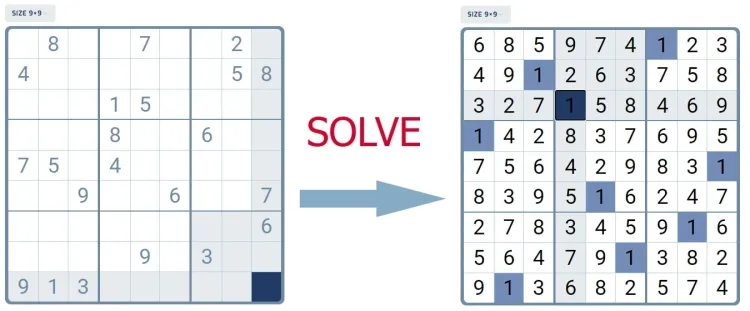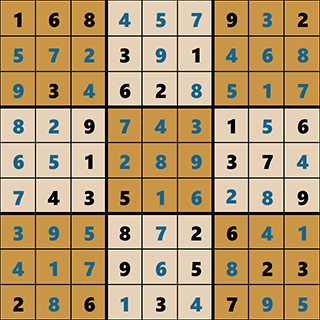Sudoku: Rules and Uses...!!!
Sudoku is more than just a puzzle; it is a versatile and valuable activity with numerous benefits. From sharpening cognitive skills to providing relaxation and entertainment, Sudoku offers something for everyone. Its simple yet challenging nature makes it a timeless classic that continues to captivate and engage people worldwide.

Sudoku is a captivating logic-based number puzzle that has enthralled millions around the globe. The objective is straightforward: fill a grid with numbers so that each column, row, and smaller grid contains all the digits without repetition.
Basic Rules of Sudoku
-
Grid Structure:
-
A standard Sudoku puzzle features a 9x9 grid divided into nine 3x3 subgrids or regions.
-
The grid starts with some cells pre-filled with numbers, referred to as "givens".
-
-
Objective:
-
The aim is to fill the empty cells with numbers from 1 to 9.
-
Each row must contain all the digits from 1 to 9 without repetition.
-
Each column must contain all the digits from 1 to 9 without repetition.
-
Each 3x3 subgrid must also contain all the digits from 1 to 9 without repetition.
-
-
Rules of Placement:
-
No digit can be repeated within a single row.
-
No digit can be repeated within a single column.
-
No digit can be repeated within a single 3x3 subgrid.
-
-
Uniqueness:
-
Each puzzle has a unique solution that can be reached through logical deduction without guessing.
-
Techniques for Solving Sudoku
-
Scanning:
-
Look for obvious placements by scanning rows, columns, and subgrids to determine where specific numbers can or cannot go.
-
This helps identify numbers that must be placed in specific cells.
-
-
Elimination:
-
Use the process of elimination to narrow down the possible numbers for each empty cell.
-
By ruling out numbers already present in a row, column, or subgrid, you can deduce the correct number for a cell.
-
-
Penciling In:
-
Write small numbers in the corners of empty cells to represent possible candidates.
-
This helps keep track of potential numbers and makes it easier to spot patterns.
-
-
Cross-Hatching:
-
Focus on a specific number and determine where it can be placed within each row, column, and subgrid.
-
This technique involves cross-referencing the placement of a number across different parts of the grid.
-
-
Advanced Strategies:
-
Techniques like X-Wing, Swordfish, and Naked Pairs can be used for more complex puzzles.
-
These strategies involve identifying patterns and relationships between cells to further narrow down possibilities.
-

Uses of Sudoku
-
Brain Exercise:
-
Sudoku is an excellent way to keep the brain active and sharp.
-
It enhances cognitive skills such as logical thinking, problem-solving, and memory.
-
Regularly solving Sudoku puzzles can improve concentration and mental agility.
-
-
Stress Relief:
-
Many people find Sudoku to be a relaxing and enjoyable activity.
-
It provides a sense of accomplishment and satisfaction upon completing a puzzle.
-
Engaging in Sudoku can help reduce stress and anxiety by offering a mental escape.
-
-
Educational Tool:
-
Sudoku is used as an educational tool to teach logical reasoning and critical thinking.
-
Teachers often incorporate Sudoku puzzles into their lessons to engage students and develop their analytical skills.
-
It can also be used to reinforce mathematical concepts and improve number sense.
-
-
Entertainment:
-
Sudoku is a popular form of entertainment enjoyed by people of all ages.
-
It is commonly found in newspapers, puzzle books, and online platforms.
-
Sudoku competitions and events are held worldwide, attracting enthusiasts and puzzle solvers.
-
-
Social Interaction:
-
Sudoku clubs and groups offer opportunities for social interaction and camaraderie among puzzle enthusiasts.
-
Sharing strategies and solving puzzles together can foster a sense of community and connection.
-
-
Therapeutic Use:
-
Sudoku puzzles are used in therapeutic settings to aid in cognitive rehabilitation.
-
They can benefit individuals recovering from brain injuries or suffering from cognitive decline.
-
Sudoku helps stimulate brain function and provides a structured activity for mental engagement.
-
-
Travel Companion:
-
Sudoku is an ideal travel companion, providing entertainment during long journeys.
-
Its portable nature makes it easy to carry and enjoy anywhere, whether on a plane, train, or bus.
-
-
Challenge and Competition:
-
For those seeking a challenge, Sudoku offers varying levels of difficulty, from easy to expert.
-
Competitive Sudoku solving is a growing trend, with national and international championships showcasing top solvers' skills.
-
Sudoku is more than just a puzzle; it is a versatile and valuable activity with numerous benefits. From sharpening cognitive skills to providing relaxation and entertainment, Sudoku offers something for everyone. Its simple yet challenging nature makes it a timeless classic that continues to captivate and engage people worldwide.
What's Your Reaction?
















